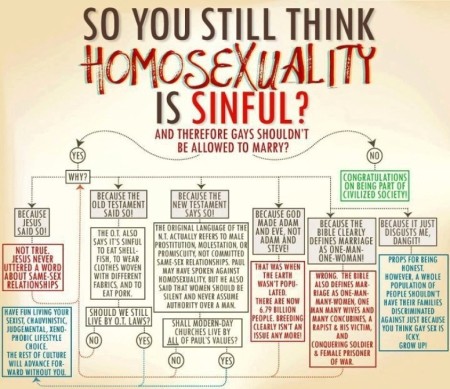One of those memes that propagates on Facebook...

Deconstructed here.
Like every other flowchart I’ve seen on this question, it conflates three things found in the Book of Leviticus: (1) expressions of the moral law (like the Ten Commandments, or the prohibition against homosexuality and other forms of sexual immorality); (2) temporal punishments; and (3) the so-called ceremonial law (like the laws on keeping kosher).
The moral law, as an expression of what is good and evil, is timeless. Good doesn’t suddenly become evil, or vice versa, because it’s Tuesday, instead of Monday, or because it’s 2015 A.D. and not 2015 B.C.
But the particular statutory punishments *weren’t* timeless: they were quite explicitly the law books of the nation of Israel. These laws can be illuminating, in that they show the severity of certain sins, but the Church never considered Israel’s statutory punishments to be binding on Christians. And the ceremonial laws were a way of setting apart the Jewish people to signal them as chosen and to prepare them for Christ.
....
The idea that Paul doesn’t really condemn homosexual behavior is based on a selective interpretative of two Greek words that he uses in 1 Corinthians 6:9: pornos (πόρνος) and malakos (μαλακός). Pornos means:
- a man who prostitutes his body to another’s lust for hire
- a male prostitute
- a man who indulges in unlawful sexual intercourse, a fornicator
- soft, soft to the touch
- metaph. in a bad sense
- effeminate
- of a catamite
- of a boy kept for homosexual relations with a man
- of a male who submits his body to unnatural lewdness
- of a male prostitute
So the Greek terms used in Paul’s day weren’t specific to only adult male-male sexual behavior (since a great deal of it was man-boy), but they certainly included those behaviors. But besides this, Paul and several other parts of the New (and Old) Testament condemn fornication. That’s broader still, but it shows that non-marital sex is sinful… regardless of who the parties are. (This raises the question: what sort of sexual unions are marriage-material? And we’ll get to that shortly).
....

But there’s a second problem with this claim. It assumes that the Bible is essentially a rule book full of Thou Shalt Not’s. But it’s missing that both Jesus and St. Paul present a positive view of marriage. That is, Scripture shows us what marriage is, which is why we can also say what itisn’t.
This is important, because as we saw from the attempts to work around St. Paul’s prohibitions, the same-sex marriage side is essentially arguing: “but here’s an arrangement nobody had thought of back then!” With a positive view of what marriage is, we can easily establish whether some new sexual variation is compatible with marriage or not.
No comments:
Post a Comment